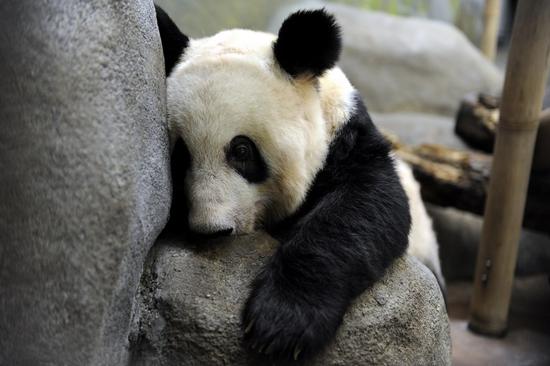Giant panda Yaya well cared for, expert says
Giant panda Yaya has been well cared for since being lent to the Memphis Zoo in the United States in 2003, and no signs of neglect have been found, a Chinese expert said in response to panda lovers' concerns about her health.
Xie Zhong, senior engineer and vice-president of the Chinese Association of Zoological Gardens, also said that China will bring back two giant pandas lent to the US, including Yaya, as soon as possible because the two are old and Yaya, who is 22, has skin disease.
Xie said that the association organized experts from zoos and research centers to assess Yaya's health condition after giant panda lovers raised concerns about whether Yaya had been neglected.
Results based on videos of the giant panda, monthly health reports and annual physical examinations showed that Yaya's blood tested normal and nothing was detected in an imaging examination. The panda's health level was found to be moderate.
A representative sent by the Chinese Embassy in the US to inspect the breeding of giant pandas at the Memphis Zoo confirmed that the pandas have been cared for well.
In 2006, Yaya began to lightly shed fur, and the situation worsened in 2014. Experts from the Memphis Zoo and China adopted many treatment options but didn't get good results, Xie said.
"The skin disease has genetic origins. As the panda gets older, hormonal fluctuations caused by changes of season can result in sparse and uneven fur. It is difficult to cure the disease, which poses a big challenge to current captive giant panda breeding," Xie said.
In 2003, Yaya, who was born in the Beijing Zoo, and male giant panda Lele, born in the Shanghai Zoo in July 1998, traveled to the Memphis Zoo in the US state of Tennessee as part of a Sino-US giant panda protection and research program.
It had been determined that the Memphis Zoo, founded in 1906, had capable wildlife breeding management, disease prevention and control, and safety management programs, Xie said.
The zoo spent $16 million to build a giant panda facility with traditional Chinese cultural elements, set up a breeding management and veterinary team, and planted about 4 hectares of bamboo.
Since the giant pandas arrived in the US, the zoo has submitted to the Chinese side monthly health reports including their daily weight and food intake. The zoo also submits annual medical examination reports, Xie said.

